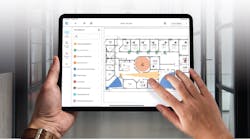With the increased commoditization of video surveillance hardware that has occurred in recent years, many vendors have been forced to look beyond competing on price alone to try and differentiate themselves with offerings and features that their integrator partners can sell for a premium. While many have opted to immerse themselves in the latest wave of video analytics driven by advances in machine learning technology, others have chosen to focus on streamlining the installation process itself, thereby driving increased efficiencies for integrators and end-users.
At this year’s GSX conference in Las Vegas, Bosch has decided to take simplifying the installation process even further with the launch of its new FLEXIDOME IP starlight 8000i camera series, which when used in conjunction with the company’s Project Assistant app, can result in much greater efficiencies with regards to planning, pre-configuring and commissioning video surveillance projects.
According to Jim Kasperek, Regional Marketing Manager for Bosch Security and Safety Systems, while the company has historically been highly focused on the performance of its products, in the development process for the 8000i series they also wanted to address some of the common challenges faced by integrators during installation.
“Through conversations with a lot of integrators globally, there were several factors that all of them run into,” Kasperek explains. “One is the talent pool which they’ve got the ability to pull from, how much time they are spending (on projects) and the tools they need. As we’ve done with other products, we took an approach of how can we address those concerns and one way to do that was to simplify the installation.”
With that in mind, Kasperek says they started to think about how they could accomplish this and they decided to make the cameras modular in nature, allowing integrators to use some of the same base components so that they could leverage those while also still being able to install new imaging devices.
“If they want 1080p, 4K or 6-megapixel imager, the imaging device is really irrelevant to the mounting hardware, which makes it easier on the integrator by saving on time and talent,” Kasperek says. “A lot of integrators will use third parties to pull cable because they want to keep their labor force numbers down so a lot of them ask, ‘How do we get the mounting plates or the base plates? Can we do that?’ We’ve separated those entities so that you can install a mounting plate and whenever the integrator or whoever is responsible for the camera install comes in, they show up, hang the mounting base, plug in the Ethernet, click it into place, and then they can place the imaging device onto the base and within 30 seconds, the camera is powered up and now they have the ability via Wi-Fi that’s built into the camera to connect to it using the app and see what the camera is doing from a mobile device.”
Aside from simplifying camera installation and commissioning, Troy Wideman, who also serves as a regional marketing manager for Bosch, says integrators they spoke with wanted to streamline their pre-planning process which involves determining how many cameras will be needed, where they need to be placed and how many people will be required to do the job effectively. “Any time saved in that process is dollars that go back to their bottom line, so it is quite important that ease of installation is a high-priority item,” he says.
For a reference point on how to bring these installation advantages to the surveillance market, Kasperek says the company looked at their intrusion business and how similar methods employed there benefited the integrator.
“If they’re saving 50 percent of labor on installations because the system is easier to install, they will realize that when they look at their burden rate versus the hours they have to put in or the talent pool they need to use and the different burden rates that apply,” Kasperek explains.
According to Wideman, the time it takes for an integrator to commission a camera is extremely important to their bottom line and that by leveraging the Project Assistant app they can take care of all of the installation legwork – setting passwords, assigning IP addresses, etc. – in advance.
“The app will actually let you start creating a project from the beginning as early as the bid process and you can start building out the installation on the app without any physical cameras in place, including usernames, passwords, IP SKUs and anything of that nature” he says. “When you do get physical cameras, it will allow you to scan the QR codes that are on the boxes of our cameras, which are then synched up based on the pre-defined information entered into the app.”
With this capability, Wideman said integrators they spoke with estimated they would be able to save about 30 percent of their typical installation time on most surveillance projects. “We can all imagine how much 30 percent of their time can relate to bottom line dollars, so it is extremely critical we help them with that,” he adds.
About the Author:
Joel Griffin is the Editor-in-Chief of SecurityInfoWatch.com and a veteran security journalist. You can reach him at [email protected].


